 Culture
and Traditions Culture
and Traditions |
I. TRADITIONAL HOLIDAYS
Kazaks love to celebrate holidays and special occasions.
During these times, Kazaks often dress in their
traditional Kazak clothes. Villages or city neighborhoods
will set up yurts nearby where they host elaborate
meals. Kazaks will frequently go to visit friends
and family, bearing gifts of flowers and candy.
Games, horseracing, singing contests and dancing
are also part of the traditions associated with
celebrations.
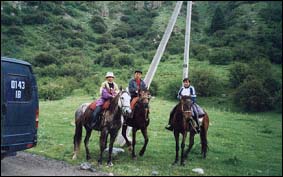
a) Calendar of Holidays
The following public holidays are observed in Kazakhstan:
1-2 January New Year
8 March International Women's Day
22 March Nauryz (first day of the Muslim New Year)
1 May Day of Inter-ethnic Accord of the Peoples of Kazakhstan
9 May Victory Day
30 August Constitution Day
25 October Republic Day
16 December Independence Day
b) Nauriz : Holidays in Spring
It is the most ancient festivity of Oriental nations. In fact, it is a New Year's Eve according to the ancient Oriental calendar. It has yet another name "Ulys Kuni"("The first day of the New Year") or "Ulystyn uly kuni" ("The great day of the people").
Kazakhs say that the more you are in celebrating the Nauryz holiday, the greater success will attend you throughout the year. When the holiday comes, Kazakhs would put on festive clothes, pay visits to each other, exchange congratulations, best wishes of well-being and good luck in the coming year. Festivities are accompanied by universal merry-making, games, traditional horse-races, various amusements.
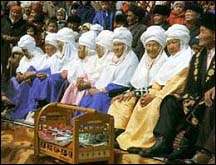
Traditionally they cook and roast and make all sorts of tasty meals during the holidays, for they should symbolize well-being and abundance in the coming year. The feast is usually timed to the noon; it is preceded and followed by a prayer in honor of the fore-fathers read by the mullah. In conclusion the eldest of those present gives his blessings (bata) so that year in year out prosperity be part and parcel of the family.
When Kazakhs celebrate Nauryz, presence of the figure of "7" is indispensable. It embodies 7 days of the week - time units of universal eternity: in front of aksakals ("white beards" or old men) they would put 7 bowls with the drink of "Nauryz-kozhe", prepared of 7 grades of 7 types of cereals.
c) Kurban Bayram (Eid al-Adhaa)
Is a religious holiday among Muslims; Easter and Christmas among Christians. Traditionally they choose the best ship and cook different tasty meals. During this holiday people visit each other, tables (dastarkhan) are fool of food, everyone is welcome this day.
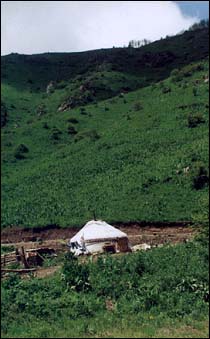
II. ENTERTAINMENTS
a) Berkutchi : Hunting with a golden eagle
Berkutchi is a tradition that has already been practiced
for ten centuries. Kazakhs say that presenting a
youngster with a fledgling of a hunting bird is
tantamount to wishing him to be brave and strong
young fellow.
Virtually training of a golden eagle
is a rare and painstaking art. The bird just caught
is being slowly trained to its master (a berkutchi).
For the purpose the man doesn't get a wink of sleep
for several nights with the bird being subjected
to similar discomfort. The bird must take food (pieces
of raw meat) from its master's hand only. When the
eagles has got used to the hunter, its horse and
its dog, it undergoes training: first It "hunts"
stuffed foxes and only then proceeds with real hunting.
Many songs and ballads were composed about these
hunting birds and their masters.
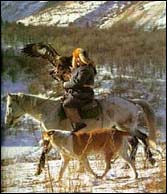
b) National Games: Kyz Kuu and Kakpar
Kyz Kuu ("Overtake the girl") is the game
where young boys and girls are participants. The
girl on the horse does her best to gallop from the
young man but as soon as the latter tries to overtake
(approach) her she lashes him with a whip. If, up
to a certain place, the young boy fails to overtake
her she would "reward" him with whipping again.
When the luckiest catch up with the girl, he snatches
a headscarf out of her teeth. If he is successful
he earns a kiss.
Kokpar ("Fighting for a goat's carcass")
is the most popular Kazakh game. It takes its origin
from an ancient tradition according to which, one
who wants to get rid of evil, should sacrifice a
goat. Up to 1,000 horsemen take part in the game.
The game unfolds on an almost infinite steppe range.
On the opposite ends of an immense field they arrange
goals of teams - adversaries. It is into them that
the symbolic carcass of the goat should be thrown,
while the throw proper is preceded by a desperate
flight between the teams to get hold of the carcass.
III. SOCIAL EVENTS
a) Wedding ceremony
In Kazakh traditions wedding lasts 40 days beginning
with matchmaking. Either the fiancé sends
matchmakers to his bride's parents, or he abducts
his fiancée. In the first case the matchmakers,
who are the fiancé's relatives, bring rich
gifts to the bride's parents and ask their consent
to the marriage. This negotiation is called the
kudaga tusu. If the bride' parents agree, then they
fix the kalym (ransom) for the bride and the wedding
day. |
Sometimes it is the bride who has the right to choose
to accept the offer. Instead of direct refusal,
the girl would give man some difficult and almost
unrealizable task. A legend tells about such a case.
Abylai Khan fell in love with a beautiful girl from
a poor family. But she already had her intended
- an ordinary warrior. As to not hurt Abylai Khan's
feelings and bring his anger on her family, the
girl requested Khan shoot an arrow beyond the mountain
near a lake. The girl went to a rock in the middle
of the lake to watch the competition. However hard
Khan tried to shoot the arrow high in the sky, it
would not rise beyond the mountain. Since then,
the mountain is called Okzhetpes, which means "unachievable
with an arrow". The girl had decided that if
Khan fulfilled her task, she would jump from the
rocky island onto the stones protruding out of the
water. That is why the lake is called Zhumbaktas,
which means "a riddle-stone".
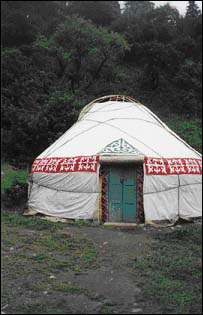
b) Betashar
The beautiful custom of betashar-
the ceremony of unveiling the bride's face - arose
from the fact that in olden days the groom would
rarely have seen his intended prior to the wedding.
The bride in all her finery, her face veiled, is
presented to the groom and his relatives. The master
of ceremonies, usually an akyn (bard), introduces
the bride to all the wedding guests. During the
wedding the bride sits behind shymyldyk - a festive
curtain which conceals her from strangers' glances.
Any wedding is accompanied by contests and games.
Young people compete in telling jokes. Aksakals
("white beards") listen to the akyns improvising
on serious social issues. Jigits (horsemen) compete
in wrestling, archery and horse racing. The idea
behind all the revelry is the union of two hearts,
two families and two clans. After the feast the
newlyweds leave for their own yurt accompanied by
a wedding song -zhar-zhar - about the joning of
two halves into a single whole.
c) The birth of a baby
Without doubt this is a momentous occasion
in any family. For forty days after the birth, no
one but immediate family may see the mother and
the baby. Interestingly, it is not for Kazakhs to
celebrate the birthdays, only mushel zhas when the
Oriental twelve-year cycle comes to an end and the
year of the person's birth repeats.
d) 40 days
When
a baby is forty days old, he is given a name at
the morning call to the prayer (azan). The name
is usually chosen by the eldest relative or the
mullah. After reading allowed some sacred words
from the Koran, the mullah pronounces the child's
name three times into his ear. It has long been
considered lucky to be born on Nauryz. The most
important part of the ceremony is the washing of
the baby. The women pour forty spoons of water into
a bowl, throw some silver coins and ornaments into
it, and bathe the baby in this water. After the
bath the baby's head is shaven and his nails are
cut, and the silver is distributed among all the
women present. The vest, which the baby wore until
his fortieth day, is filled with sweets, tied into
a bundle and hung round a dog's neck. The sweets
are grabbed by the children who manage to catch
the dog and untie the bundle, while vest is taken
by a childless woman - in a hope of having a baby.
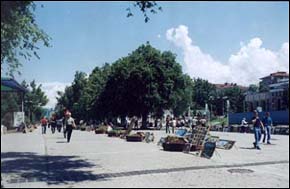
e) Cutting the hobble
When a child is only just beginning to walk, he undergoes another ancient ritual - cutting the hobble. A hobble - a rope wound around the legs in a figure-of-eight - is tied around the child's legs. The child takes a few steps, then the hobble is cut by the most respected guest, one whose life is worthy example. By cutting the hobbles he blesses the baby to go through his own life more successfully.
IV. MUSICAL ARTS AND MUSICAL INSTRUMENTS
"It seems to me all the Kazak steppes are singing" -- Zataevich (a famous Kazak author). Music is a very important part of Kazak life. Nowadays they know about more than 50 varieties of Kazakh musical instruments. Each of them produces specific sounds and requires particular manner of playing it. To manufacture musical instruments they use such materials as wood, reed, cane leather, bane, horn, horse's hair.
Dombra - an instrument most widespread among
the people, manufactured of one piece of wood, commonly
a two-string one. There actually exist two ways
of playing a dombra: by striking the strings with
the fingers and by "nibbling" them separately. Its
sounds accompany competitions of improvising poets.
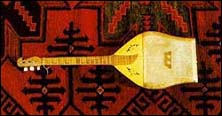
Kobyz - an ancient Kazakh bow two-string
musical instrument manufactured in the form of a
scoop out of on piece of wood. A legend about the
kobyz says once, Genghis Khan ordered the spine
of his favorite but stubborn son Dzhuchi to be broken.
According to custom, anyone who told bad news to
the master was condemned to death. When the corpse
of Khan's son was found, no one dared to bring this
awful news. People asked a respected singer akyn
to help in the situation. Akyn took his kobyz and
began playing. Sad were the kobyz' sounds. When
Genghis Khan understood that his son is dead, the
news brought the cruel warrior to tears.

Aitys - a competition of improvisators in
performing songs, one of traditional manifestation
of oral folk poetic arts. It is deeply rooted in
ancient times and stems from in ritual and every-day
songs, in chorus-like songs-dialogues exchanged
by young boys. Not infrequently they raised quite
topical issues of social life when staging aityses.
An aitys is full of dynamics, it requires particular
quickness and brightness, an uncommonly fine wit
and improvisation skills. Akyns accompany their
poetic contests with their playing a dombra or a
kobyz. An aitys of akyns is essentially a topmost
manifestation of improvisation skills. Usually it
is staged at folk festivals, fairs and the like.
Initiating the singing contest its participants
- akyns - must be uncommonly quick in finding witty
repartees to sudden questions, in instant countering
the adversary's gibes and sneers. The brighter and
wittier is the improvised fireworks of words produced
by the akyn, the more chances for him to come victorious
out of this battle.
From time immemorial Kazakhstan
has been known for its singers - representatives
of the folklore musical and poetic culture. They
used to call them: Akyn - a poet, a singer
and improvisator; Zhyrau - author and performer
of epic things; Anshi or Olenshi -
song-performers. There have been recorded plentiful
specimens of poetic arts: terme, zyr, tolgau. |

